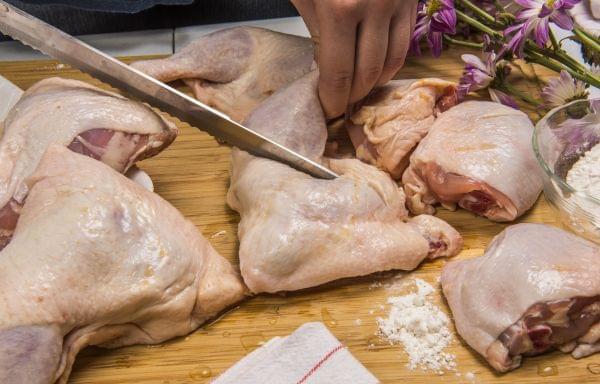USDA Targets Salmonella In Chicken Wings And Other Poultry Parts

The USDA proposed standards for cut up poultry parts last month. Photo illustration by Darrell Hoemann
Chicken wings and ground turkey may become safer if the U.S. Department of Agriculture passes new standards to limit the presence of salmonella.
According to government reports, poultry products cause more food-borne illness deaths than any other commodity.
And while the USDA has focused its efforts on curbing contamination in whole turkey and chicken carcasses, it does not have limits on salmonella for cut-up poultry.
“The USDA was finding that when the carcass goes to be cut up and made into breast fillets and other parts, sometimes salmonella prevalence can increase on those parts,” said Scott Russell, poultry science professor at The University of Georgia and author of the book “Salmonella in Poultry Meat Production.”
Last month, the USDA proposed federal standards to reduce the bacteria salmonella and campylobacter in ground chicken and turkey, chicken breasts, legs, and wings. The move comes ahead of a new federal plan proposed by President Barack Obama to create a single food safety agency.
Russell said companies were able to meet the standards for salmonella with whole carcasses — which is 7.5 percent contamination when the meat is tested — but once the carcass was cut up, cross contamination and other factors made that standards more difficult to attain.
The proposed standards limit the maximum amount of salmonella allowed in chicken parts at 15.4 percent. The government’s goal is to reduce salmonella foodborne illnesses by at least 30 percent by 2020.
Company officials for one of the largest U.S. producers of turkey parts said they are ahead of the proposed change.
Scott Eilert – vice president of food safety, quality and regulatory for Cargill Turkey and Cooked Meats – said in an email that Cargill “embraced the salmonella-reduction challenge more than a year ago when it began a program to rapidly test for Salmonella.”
In 2011, the company recalled 36 million pounds of ground turkey products produced in its Arkansas plant because of salmonella contamination. The outbreak sickened 130 people and was responsible for at least one death, according to the Centers for Disease Control and Prevention.
Eilert said now, in addition to weekly USDA inspections, Cargill takes daily samples in plants that produce raw ground turkey and only releases uncontaminated product to consumers.
The company produces one billion pounds of poultry a year, he said.
Pushed too far or not enough?
Russell said at a certain point the regulations are too extreme because the number of salmonella on carcasses and parts that end up in the positive range is usually very low and would be unable to carry disease.
“It gets to a point where you say, ‘Wait a minute, USDA.’ How far can you push the industry to keep pushing and pushing to lower salmonella?” he said. “It defeats the purpose in some ways.”
But Paige Tomaselli – Center for Food Safety senior attorney – argued that more detailed standards are necessary.
“For the consumer or the public, we don’t actually receive the [contamination] test results,” Tomaselli said. “What we do know is that foodborne illness happens, that outbreaks happen, and that people are getting sick.”
In 2014, a salmonella outbreak linked to Foster Farms chicken sickened over 600 people.
The CDC estimates salmonella causes more than a million illnesses in the United States and 380 deaths every year.
“We have not significantly reduced the number of foodborne illnesses in years, in large part to outdated standards,” said Sen. Dianne Feinstein (D-Calif.), who wrote to Congress about poultry standards in November, in a press release.
“The meat industry has already demonstrated its ability to reduce contamination rates, and I am confident that it will successfully adapt to the new standards to improve public health,” she said.
The Food Safety and Inspection Service agency is currently accepting public comments on the poultry standards and will announce the final standards and an implementation date this spring.
